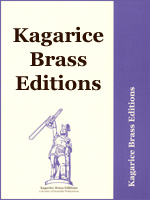Gilroy, Gary Fanfare & Bone Dances for Bob
Trombone Sextets

-
Gilroy, Gary
Fanfare & Bone Dances for Bob [solo trombone & quintet]
21st Century (2005). For solo trombone (tenor clef) and trombone quintet (all in bass clef) (6 parts total). An exciting and fun four movement work whose movement titles include Fanfare; Cartoon Dance; Slow Dance; and Frantic Dance. Rhythmically active, highly tonal and accessible to audiences and players alike. The solo part is intended for a strong player with high chops, while the ensemble parts are suitable for college or good high school level players. Written for Tom Ashworth and the Clovis High School Trombone Ensemble. Score & parts.# solo trombone and trombone ensemble
-
- Category: Trombone Sextets
- Item: 055669
- Grade/Level: Grade 5 - Early Advanced
- Price: $25.00
-
(usually ships in 24 hours)
